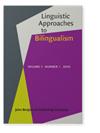天真的英语学习者对间接积极证据的使用
IF 1.8
2区 文学
0 LANGUAGE & LINGUISTICS
引用次数: 0
摘要
当第二语言学习者面临习得母语语法子集的语法时,没有直接的积极证据。我们质疑学习者是否可以使用间接的积极证据:来自母语为学习者第二语言的人在学习者第一语言中犯下的错误的证据。我们研究了天真的英语普通话学习者是否能够从讲普通话的人的英语作品中的复数省略错误中确定,普通话在英语的一个子集条件下标记复数。参与者通过英语对话接触到间接的积极证据,在对话中,母语为普通话的对话者将所有上下文中的复数名词都作为单数。随后,参与者在单数语境中学习了12个类似普通话的名词,之后使用单数和复数图片作为提示对他们的单词学习进行了测试。40%的参与者正确地推断出,他们赋予单数解释的字符串在复数上下文中也是合适的。后续问题显示,他们注意到了对话中的错误,并用这些错误来帮助他们理解普通话中的复数标记。这一结果表明,间接积极证据可能是真实语言学习者学习母语语法子集语法的有效工具。本文章由计算机程序翻译,如有差异,请以英文原文为准。
Naïve English-speaking learners’ use of indirect positive evidence
When second language learners are faced with acquiring a grammar that is a subset of their native language
grammar, direct positive evidence is unavailable. We question whether learners can instead use indirect positive evidence:
evidence drawn from errors in the learner’s L1 made by native speakers of the learner’s L2. We examine if naïve English-speaking
learners of Mandarin can determine from plural omission errors in Mandarin speakers’ English productions that Mandarin marks
plural in a subset of conditions under which English does. Participants were exposed to indirect positive evidence via an
English-medium dialogue where a native Mandarin-speaking interlocutor produced all contextually plural nouns as singulars.
Subsequently, participants learnt 12 Mandarin-like nouns in singular contexts, after which their word learning was tested using
both singular and plural pictures as prompts. Forty percent of participants correctly deduced that strings to which they had
assigned singular interpretations were also appropriate in plural contexts. Follow-up questions revealed that they noticed the
errors in the dialogue and used these to inform their understanding of plural marking in Mandarin. This result suggests that
indirect positive evidence may be an effective tool for real language learners to acquire a grammar that is a subset of their
native grammar.
求助全文
通过发布文献求助,成功后即可免费获取论文全文。
去求助
来源期刊

Linguistic Approaches To Bilingualism
Social Sciences-Linguistics and Language
CiteScore
3.20
自引率
9.10%
发文量
24
期刊介绍:
LAB provides an outlet for cutting-edge, contemporary studies on bilingualism. LAB assumes a broad definition of bilingualism, including: adult L2 acquisition, simultaneous child bilingualism, child L2 acquisition, adult heritage speaker competence, L1 attrition in L2/Ln environments, and adult L3/Ln acquisition. LAB solicits high quality articles of original research assuming any cognitive science approach to understanding the mental representation of bilingual language competence and performance, including cognitive linguistics, emergentism/connectionism, generative theories, psycholinguistic and processing accounts, and covering typical and atypical populations.
 求助内容:
求助内容: 应助结果提醒方式:
应助结果提醒方式:


